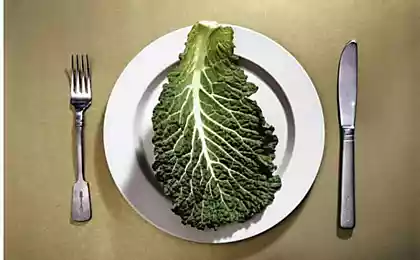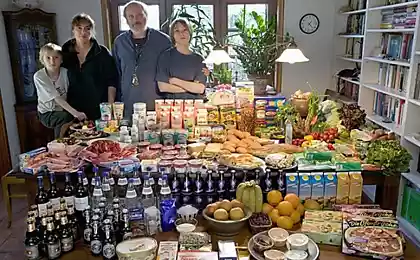1062
11 foods that grow in unusual ways (14 photos)
How often have you thought about how to grow in the nature of the products that appear on our table, what species of plants and how they are treated? Sometimes, for the most familiar to us things hiding something amazing and unimaginable. Chocolate, cashew nuts, black pepper, baby corn, cinnamon, wasabi, pineapple, kiwi, sesame seeds, saffron, asparagus. Do you know how they grow?
1. Cashew
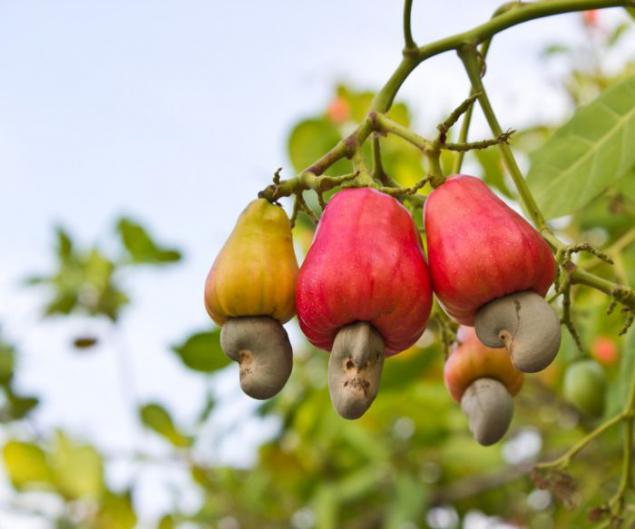
Why cashew is considered the most expensive varieties of nuts? And because each cashew nut - it's actually one seed the size of a mango fruit, which is called an apple-kazhu. Seed hangs from the bottom of the fetus in the shape of an inverted heart. Processing cashew - quite a complicated process, because what we eat as a nut, enclosed in a two-layer membrane, which turns out to contain toxic oils, reminiscent of the action of toxins poison ivy. Therefore, in order to get rid of hazardous substances and to obtain the edible part of the nuts, seeds need a good fry.
Apple-kazhu - fruit with soft pulp, which has a sweet and spicy taste and because of the high content of tannins in the mouth leaves a feeling of dryness (after the unripe banana). The fruit is very popular in places such as Brazil, where it is consumed fresh or used to make juice, syrup, wine and candied fruits.
2. Mini corn
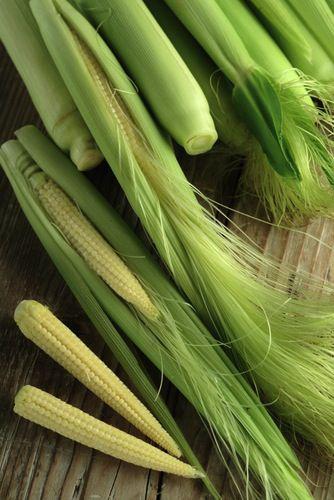
Mini corn variety is not new, as many people. In fact, it is common corn that break immediately before pollination, when it still does not have time to ripen. Mini corn crop can be harvested only after the stalk of the plant reaches a height of about 2 meters, so it is unlikely it is suitable for cultivation at home on a window sill.
3. Cinnamon
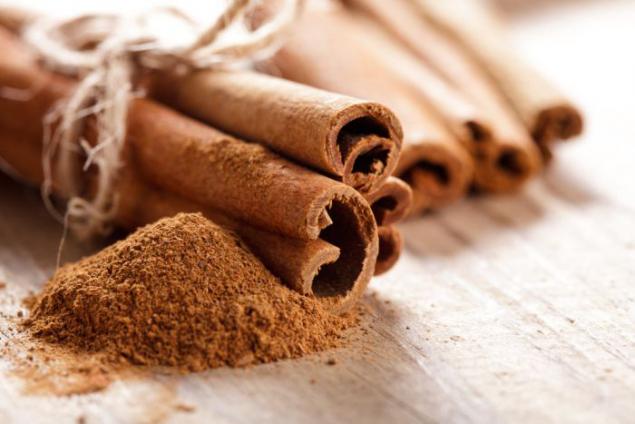
Cinnamon - inner bark grows in subtropical regions of Ceylon Cinnamomum or cinnamon tree native to Sri Lanka. It is often confused with Cinnamomum Loureiro, or Vietnamese cassia. An interesting fact is that today, for commercial production is preferably used cassia, so most of the cinnamon we buy in the market, is in fact a fake. True cinnamon is more flavorful and not as aggressive on the palate as Vietnamese.
Cinnamon trees can grow up to 15 meters in height, but usually under dilution limit is 2.5 m. For the production of spice plants typically use branches which support moist for 1-2 days to make it easier to separate the bark from the wood. Then, cut the leaves and twigs and peel the outer bark. Then proceed to remove the inner bark, making long parallel cuts. This results in thin layers that overlap each other, forming the familiar cinnamon sticks.
4. Chocolate (cocoa beans)
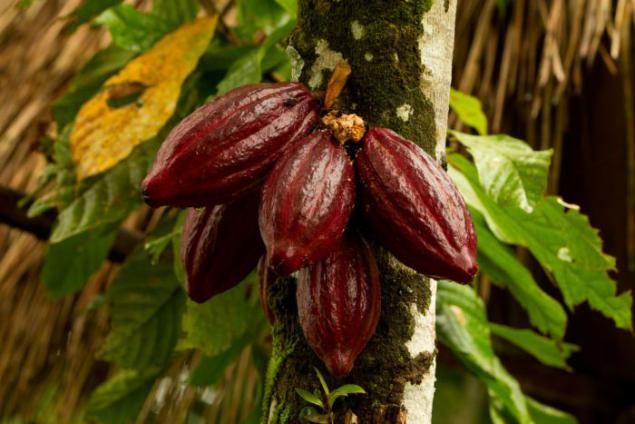
Chocolate is made from the dried fermented beans that grow inside the fruit of the cocoa tree. The pods ranging in size from 17 to 35 centimeters, shaped like a ball for the game of rugby, grow directly from the trunk or on the huge boughs. Inside the seed pods are surrounded by a sweet pulp of light color, the taste of which it has nothing to do with chocolate. Each pod there are approximately 30-50 seeds.
Initially, seed color white or pale purple, but in the process of drying and fermenting they become darker. Next, the beans are dried in an oven, milled in a grinder to remove the thin shell-peel, thereby obtaining cocoa nibs, which are subsequently used for producing various chocolate confectionery.
5. Wasabi
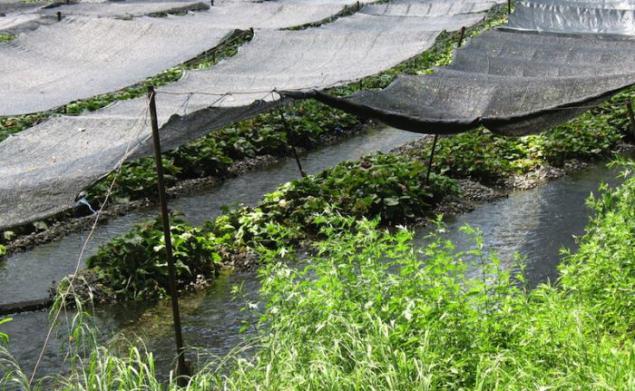
Wasabi - a root that grows in cool and wet mountain areas or under the forest canopy in vivo. Artificially plant is grown in the shade in cold running water. The maturation process can take up to 3 years. Since the breeding wasabi - a very easy and expensive affair, most of the so-called wasabi, which is now sold in the market - fake. In fact it is a mixture of conventional horseradish, mustard and food coloring. Freshly grated wasabi root is usually a creamy paste and is an essential ingredient for sushi.
This wasabi can be found only in Japan. Here it is very expensive, as is grown in a natural way.
6. Pineapple

Pineapples grow surprisingly easy. Because they do not have seeds, simply cut off the top of any of the fetus and to plant it. You can also plant processes or side shoots. Pineapple plants do not require much water and can grow in marginal soil and in the usual pot or barrel.
Pineapple plant has a short sturdy trunk, covered with long soft as wax needles. Himself fruit grows vertically and each plant produces only one fruit.
The process of growing and producing fruit pineapple takes 12 to 24 months, depending on what part of the plant you planted. However, if your garden has a few pineapples, they themselves are easy to multiply, providing you harvest the fruit for years to come.
Homeland pineapple is considered to Brazil and Paraguay, but thanks to the indigenous population, they are widely spread throughout South and Central America and the West Indies. Columbus brought fruit in Spain, where they have gained immense popularity among sailors, who used a pineapple as a remedy for scurvy. Later, they learned about the world.
7. Kiwi
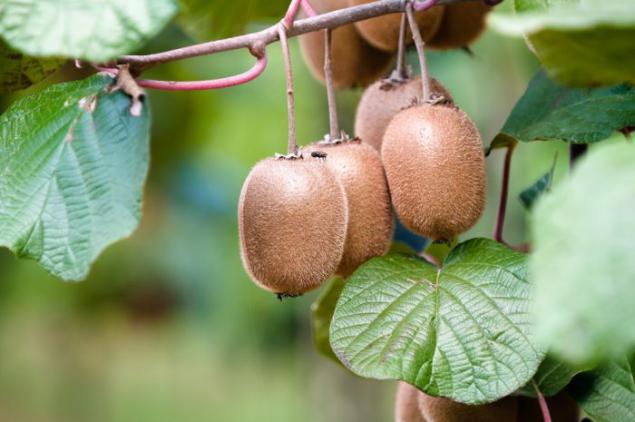
Kiwi homeland is China, not New Zealand, hence the name - "Chinese gooseberry". In New Zealand they were in 1904. There they brought the headmistress of a local school after a trip to China, and by the end of the Second World War, the kiwi has become a major export crop of the country.
In fact, the kiwi - a berry, which is grapes growing on the vine winding. Male and female plants must be planted close to each other so that they bear fruit. Kiwi is very sensitive to changes in weather conditions - at sharp change of temperature plant may die. In addition, there is a problem with its pollination, as the bees find flowers kiwi is not particularly attractive.
8. Sesame seeds

Sesame plant is the oldest known crops cultivated by man. It began to grow another 5, 000 years ago. Sesame seeds have been popular among the Roman soldiers, who used them to recuperate.
The height of mature plants, sesame is 1.5-2 meters; They have broad leaves and large, similar to the bells of flowers, and in which the seeds are. Their color depends on the plant species. And sesame seed oil is used for various purposes throughout the world.

9. Saffron

Saffron - the most expensive spice in the world, which is made from the dried flowers of purple crocus stigmata seed. For the production of 30 grams of spices takes about 75 000 flowers, the harvest of which is collected mainly by hand. Saffron is widely used in cooking, giving the dish a unique taste. The ancient Egyptians also used it to stain clothes.
10. Asparagus
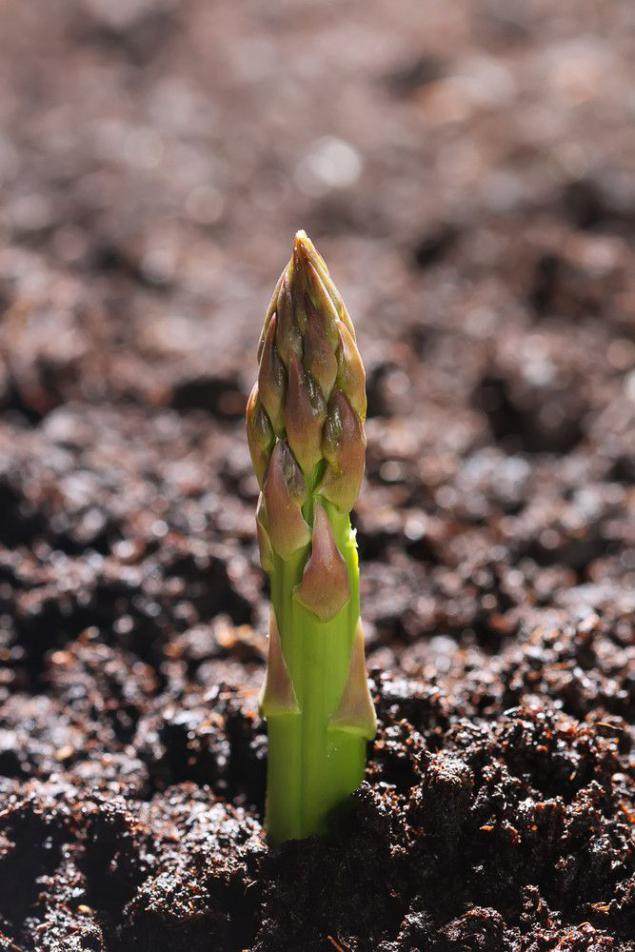
Growing asparagus - the process time-consuming and time-consuming. It will take about two years to become a little seed into a mature plant. Asparagus - a perennial plant that can live more than 20 years. Harvest asparagus can be harvested when the stems reach the diameter of an ordinary pencil.
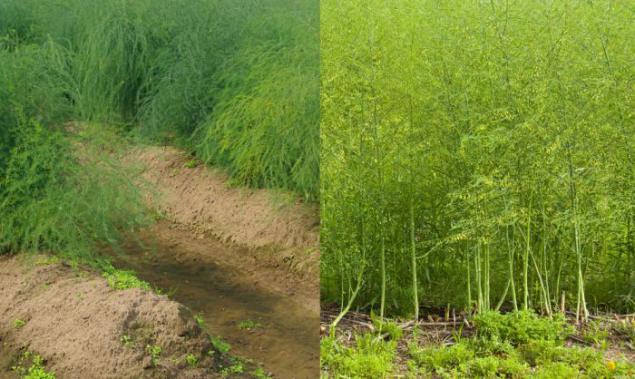
11. Pepper
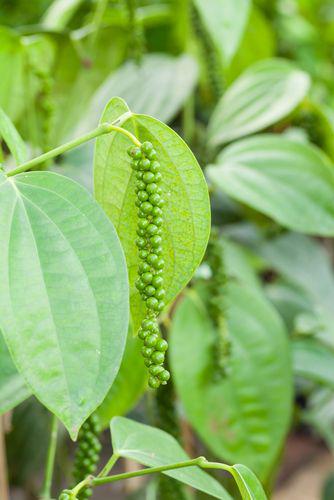
Pepper - the most common and best-known spice in the world, but have you ever thought ever over the difference between black, white, green and pink pepper? Many believe that they grow and look like beads Shambhala, which you can see here, but they do not like them ... Although ...
Black pepper - is an evergreen vine with dark green oval leaves. In artificial conditions it is grown on trees or lattices. With the stems of the plant hanging clusters of globular drupes, which are green at first, but as they mature and become darker take on a more pronounced flavor. If they disrupt still immature, while the taste is not sharp, but rather soft, refreshing. But most of the fruits are harvested when they turn black - this is a well-known black pepper. White pepper - this is the same black pepper, but slightly overripe. When the fetus is removed from the black shell, leaving only the white pith. White pepper to taste less sharp than the black, but richer in flavor.

Pink Pepper - the fruit of an entirely different plant, known as the Brazilian pepper tree. This is a tall tree with branches droop, which are growing cluster of bright pink beans. They are not as sharp on the palate and have a pleasant citrus scent.
1. Cashew

Why cashew is considered the most expensive varieties of nuts? And because each cashew nut - it's actually one seed the size of a mango fruit, which is called an apple-kazhu. Seed hangs from the bottom of the fetus in the shape of an inverted heart. Processing cashew - quite a complicated process, because what we eat as a nut, enclosed in a two-layer membrane, which turns out to contain toxic oils, reminiscent of the action of toxins poison ivy. Therefore, in order to get rid of hazardous substances and to obtain the edible part of the nuts, seeds need a good fry.
Apple-kazhu - fruit with soft pulp, which has a sweet and spicy taste and because of the high content of tannins in the mouth leaves a feeling of dryness (after the unripe banana). The fruit is very popular in places such as Brazil, where it is consumed fresh or used to make juice, syrup, wine and candied fruits.
2. Mini corn

Mini corn variety is not new, as many people. In fact, it is common corn that break immediately before pollination, when it still does not have time to ripen. Mini corn crop can be harvested only after the stalk of the plant reaches a height of about 2 meters, so it is unlikely it is suitable for cultivation at home on a window sill.
3. Cinnamon

Cinnamon - inner bark grows in subtropical regions of Ceylon Cinnamomum or cinnamon tree native to Sri Lanka. It is often confused with Cinnamomum Loureiro, or Vietnamese cassia. An interesting fact is that today, for commercial production is preferably used cassia, so most of the cinnamon we buy in the market, is in fact a fake. True cinnamon is more flavorful and not as aggressive on the palate as Vietnamese.
Cinnamon trees can grow up to 15 meters in height, but usually under dilution limit is 2.5 m. For the production of spice plants typically use branches which support moist for 1-2 days to make it easier to separate the bark from the wood. Then, cut the leaves and twigs and peel the outer bark. Then proceed to remove the inner bark, making long parallel cuts. This results in thin layers that overlap each other, forming the familiar cinnamon sticks.
4. Chocolate (cocoa beans)

Chocolate is made from the dried fermented beans that grow inside the fruit of the cocoa tree. The pods ranging in size from 17 to 35 centimeters, shaped like a ball for the game of rugby, grow directly from the trunk or on the huge boughs. Inside the seed pods are surrounded by a sweet pulp of light color, the taste of which it has nothing to do with chocolate. Each pod there are approximately 30-50 seeds.
Initially, seed color white or pale purple, but in the process of drying and fermenting they become darker. Next, the beans are dried in an oven, milled in a grinder to remove the thin shell-peel, thereby obtaining cocoa nibs, which are subsequently used for producing various chocolate confectionery.
5. Wasabi

Wasabi - a root that grows in cool and wet mountain areas or under the forest canopy in vivo. Artificially plant is grown in the shade in cold running water. The maturation process can take up to 3 years. Since the breeding wasabi - a very easy and expensive affair, most of the so-called wasabi, which is now sold in the market - fake. In fact it is a mixture of conventional horseradish, mustard and food coloring. Freshly grated wasabi root is usually a creamy paste and is an essential ingredient for sushi.
This wasabi can be found only in Japan. Here it is very expensive, as is grown in a natural way.
6. Pineapple

Pineapples grow surprisingly easy. Because they do not have seeds, simply cut off the top of any of the fetus and to plant it. You can also plant processes or side shoots. Pineapple plants do not require much water and can grow in marginal soil and in the usual pot or barrel.
Pineapple plant has a short sturdy trunk, covered with long soft as wax needles. Himself fruit grows vertically and each plant produces only one fruit.
The process of growing and producing fruit pineapple takes 12 to 24 months, depending on what part of the plant you planted. However, if your garden has a few pineapples, they themselves are easy to multiply, providing you harvest the fruit for years to come.
Homeland pineapple is considered to Brazil and Paraguay, but thanks to the indigenous population, they are widely spread throughout South and Central America and the West Indies. Columbus brought fruit in Spain, where they have gained immense popularity among sailors, who used a pineapple as a remedy for scurvy. Later, they learned about the world.
7. Kiwi

Kiwi homeland is China, not New Zealand, hence the name - "Chinese gooseberry". In New Zealand they were in 1904. There they brought the headmistress of a local school after a trip to China, and by the end of the Second World War, the kiwi has become a major export crop of the country.
In fact, the kiwi - a berry, which is grapes growing on the vine winding. Male and female plants must be planted close to each other so that they bear fruit. Kiwi is very sensitive to changes in weather conditions - at sharp change of temperature plant may die. In addition, there is a problem with its pollination, as the bees find flowers kiwi is not particularly attractive.
8. Sesame seeds

Sesame plant is the oldest known crops cultivated by man. It began to grow another 5, 000 years ago. Sesame seeds have been popular among the Roman soldiers, who used them to recuperate.
The height of mature plants, sesame is 1.5-2 meters; They have broad leaves and large, similar to the bells of flowers, and in which the seeds are. Their color depends on the plant species. And sesame seed oil is used for various purposes throughout the world.

9. Saffron

Saffron - the most expensive spice in the world, which is made from the dried flowers of purple crocus stigmata seed. For the production of 30 grams of spices takes about 75 000 flowers, the harvest of which is collected mainly by hand. Saffron is widely used in cooking, giving the dish a unique taste. The ancient Egyptians also used it to stain clothes.
10. Asparagus

Growing asparagus - the process time-consuming and time-consuming. It will take about two years to become a little seed into a mature plant. Asparagus - a perennial plant that can live more than 20 years. Harvest asparagus can be harvested when the stems reach the diameter of an ordinary pencil.

11. Pepper

Pepper - the most common and best-known spice in the world, but have you ever thought ever over the difference between black, white, green and pink pepper? Many believe that they grow and look like beads Shambhala, which you can see here, but they do not like them ... Although ...
Black pepper - is an evergreen vine with dark green oval leaves. In artificial conditions it is grown on trees or lattices. With the stems of the plant hanging clusters of globular drupes, which are green at first, but as they mature and become darker take on a more pronounced flavor. If they disrupt still immature, while the taste is not sharp, but rather soft, refreshing. But most of the fruits are harvested when they turn black - this is a well-known black pepper. White pepper - this is the same black pepper, but slightly overripe. When the fetus is removed from the black shell, leaving only the white pith. White pepper to taste less sharp than the black, but richer in flavor.

Pink Pepper - the fruit of an entirely different plant, known as the Brazilian pepper tree. This is a tall tree with branches droop, which are growing cluster of bright pink beans. They are not as sharp on the palate and have a pleasant citrus scent.


